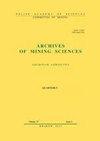About Some Problems Related to Determination of the E.G. Biot Coefficient for Rocks
IF 1.2
4区 工程技术
Q3 MINING & MINERAL PROCESSING
引用次数: 3
Abstract
use of the poroelasticity theory by Biot in the description of rock behaviour requires the value of the e.g. Biot coefficient α to be determined. The α coefficient is a function of two moduli of compressibility: the modulus of compressibility of the rock skeleton K s and the effective modulus of compressibility K . These moduli are determined directly on the basis of rock compressibility curves obtained during compression of a rock sample using hydrostatic pressure. There is also a concept suggesting that these compressibility moduli might be determined on the basis of results of the uniaxial compression test using the fact that, in the case of an elastic, homogeneous and isotropic material, the modulus of compressibility of a material is a function of its Young modulus and its Poisson ratio. This work compares the results obtained from determination of the Biot coefficient by means of results of compressibility test and uniaxial compression test. it was shown that the uniaxial compression test results are generally unsuitable to determine the value of the coefficient α . An analysis of values of the determined moduli of compressibility shows that whereas the values of effective moduli of compressibility obtained using both ways may be considered as satisfactorily comparable, values of the relevant rock skeleton moduli of compressibility differ significantly.关于确定岩石E.G.比奥系数的几个问题
Biot在描述岩石行为时使用孔隙弹性理论,需要确定例如Biot系数α的值。α系数是两个压缩模量的函数:岩石骨架的压缩模量Ks和有效压缩模量K。这些模量直接基于在使用静水压力压缩岩石样品期间获得的岩石压缩性曲线来确定。还有一个概念表明,这些压缩模量可以根据单轴压缩试验的结果确定,即在弹性、均匀和各向同性材料的情况下,材料的压缩模量是其杨氏模量和泊松比的函数。本工作比较了通过压缩性试验和单轴压缩试验确定Biot系数的结果。结果表明,单轴压缩试验结果通常不适合确定系数α的值。对确定的压缩模量值的分析表明,尽管使用两种方法获得的有效压缩模量值可以被认为是令人满意的可比性,但相关岩石骨架压缩模量的值差异很大。
本文章由计算机程序翻译,如有差异,请以英文原文为准。
求助全文
约1分钟内获得全文
求助全文
来源期刊

Archives of Mining Sciences
工程技术-矿业与矿物加工
CiteScore
2.40
自引率
16.70%
发文量
0
审稿时长
20 months
期刊介绍:
Archives of Mining Sciences (AMS) is concerned with original research, new developments and case studies in mining sciences and energy, civil engineering and environmental engineering. The journal provides an international forum for the publication of high quality research results in:
mining technologies,
mineral processing,
stability of mine workings,
mining machine science,
ventilation systems,
rock mechanics,
termodynamics,
underground storage of oil and gas,
mining and engineering geology,
geotechnical engineering,
tunnelling,
design and construction of tunnels,
design and construction on mining areas,
mining geodesy,
environmental protection in mining,
revitalisation of postindustrial areas.
Papers are welcomed on all relevant topics and especially on theoretical developments, analytical methods, numerical methods, rock testing, site investigation, and case studies.
 求助内容:
求助内容: 应助结果提醒方式:
应助结果提醒方式:


